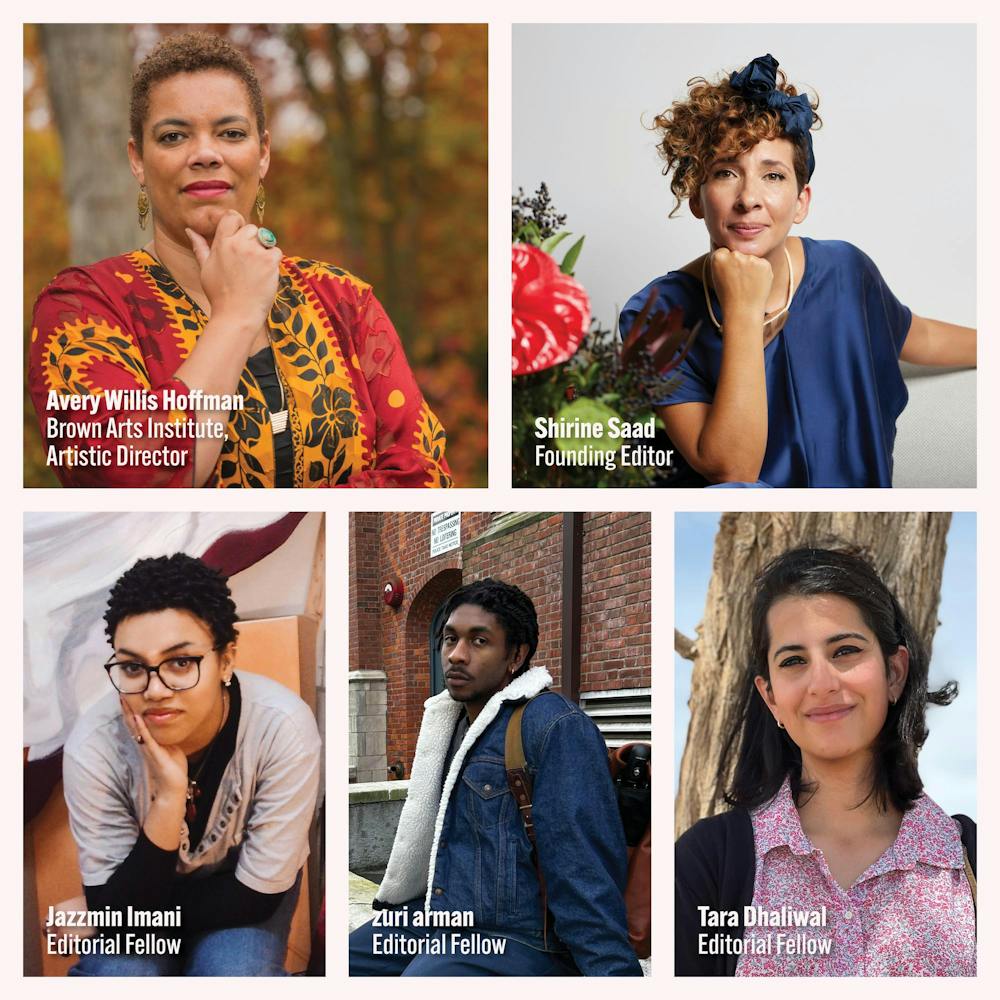The first volume of the Brown Arts Institute’s MOVEMENTS arts journal, titled “Dissonance,” launched online Friday.
“Dissonance” seeks to activate “radical theoretical flows that reconnect us with each other, nature and the world” — and serves as a “poetic remixing of freedom movements and their live manifestations in community, experimentation and creativity,” according to the MOVEMENTS website.
To celebrate the release, BAI held a “Community Jam” over Zoom, which featured student and faculty artists as well as some of the writers featured in the journal’s first issue.
The event began with a conversation between MOVEMENTS’s Founding Editor and Professor of Arts Journalism and Criticism Shirine Saad and BAI Artistic Director and Professor of the Practice of Theatre Arts and Performance Studies and Classics Avery Willis Hoffman, who discussed the underlying principles and ideas behind the journal.
Two and a half years ago, Willis Hoffman invited Saad to “join her on this adventure … because she was interested in activating (BAI’s) incredible programming through critical conversations about the themes that are being addressed on stage,” Saad said at the event.
This prompted Saad to move to Providence, where they began “to learn about the history of the land, the various changes that had been happening to the city’s infrastructure (and) the power structure in Brown and Brown’s place in the wider community and landscape,” Saad told The Herald in an interview after the event.
Saad expressed that these “explorations” and the students they recruited to help with the journal helped shape the concepts MOVEMENTS would focus on.
“We said we need to respond to the work that (Hoffman) is doing — the cultural, artistic programming — but we also need to respond to what’s happening in this city at this moment in time,” they said. “We felt that there was a need for a publication that brought theory to life.”
The name MOVEMENTS is a “play on words,” as it connotes “expanse and space” as well as “moving between disciplines,” Willis Hoffman said at the event, adding that the title is a greater testament to the multidisciplinary nature of arts at Brown.
MOVEMENTS also promotes the mission of institutions like the newly-created Lindemann Performing Arts Center, which “invites us to fail and needs us to experiment,” according to Willis Hoffman. It’s “not so obsessed with the final product” and disrupts “the transactional space of art many of us are used to.”
Willis Hoffman hopes the journal will “make space for stumbling through things, exploring and actually giving ourselves space to grieve” and “give voice” to those who have been underrepresented in the art world.
Sherente Harris ’23 GS and Silvermoon Larose, both members of the Narragansett Indian Tribe, also spoke at the event about the relationship between land and art.
“So much of our art traditions today are inseparable from our identity as Indigenous people,” Harris said. “Our arts are expressions of our relationship to the land.”
Larose expressed that until recently, she didn’t consider much of what she created to be “art” in the traditional sense. Growing up, art “was just something that surrounded us all the time,” she said. “Everyone was a creator.”
“All of what we consider traditional art forms were based in purpose and utilization,” Larose said, describing the practical purposes of basketmaking, weaving and pottery. “You built relationships with those materials” and, by making them beautiful, “you pay honor and respect to all of that creation.”
“When we dance, we dance to the beat of the drum, and that is the heartbeat of Mother Earth,” Harris explained. “And when we dance, our feet move the way that the animal people’s feet move. And we wear the skins and the feathers of our relations, the animal people, so that the lines are blurred between us and them.”
“Our stories orient the individual to our society, orient our society to our world and explain why we live the way we do in relation to the landscape around us,” they added.
Next, poet Fariha Róisín spoke with Tara Dhaliwal GS about the significance of political art and poetry.
Róisín read personal poems about her identity, her family’s history with genocide in Bangladesh and the subsequent generational trauma. She dedicated her work, which is “directed toward liberation,” to “the people in Gaza.”
Saad expressed a similar sentiment, linking global events to the work of all the journal’s contributors.
“Today, we are in mourning and many of us are grieving very intensely,” they said. “Artistic work and theoretical work help us to see clearly through the chaos, the catastrophe.”
Both Róisín and Dhaliwal also highlighted the role of community in the journal and resistance movements. MOVEMENTS was a community-based effort, enlisting contributions from students and faculty across Brown and the Rhode Island School of Design, according to Saad.
“Community is leaning on your people and working and organizing together like this,” Róisín said. “Colonization has separated us so much from each other and from ourselves … because we’re more powerful when we’re together.”
Professors of Modern Culture and Media Macarena Gómez-Barris and Alex Weheliye then discussed Weheliye’s latest book, “Feenin: R&B Music and the Materiality of BlackFem Voices and Technology.”
“The book is really a sonic and dialogical illumination of Black life and worlds,” Gómez-Barris said, adding that it “deals very closely with the question of queerness as Black musicalities.”
The event also included a conversation between Saad and composer Vijay Iyer about the relationship between musical dissonance and the body, as well as a discussion about holistic care from RISD Art Critic Lilly Manycolors and Sheida Soleimani, assistant professor of fine arts at Brandeis University.
The event closed with a conversation between writer Re’al Christian and poet danilo machado about the art of mapping movement and the systems of power behind maps.
“It’s important to always question the power dynamics embedded within cartography and mapping,” Christian said. “The way that cities are depicted on maps today is indelibly tied to these power dynamics — to the economy, to capitalism.”
Systems of power “manifest spatially,” machado said. “That spatial knowledge is something that’s then deployed by artists” to dismantle “infrastructures of power and create infrastructure of care and poetics and collaboration for ourselves as writers and artists and art workers.”
Correction: A previous version of this article included an image with incorrect attribution. The Herald regrets the error.

Katie Jain is a University News editor from New Jersey overseeing the graduate student life beat. She is a senior concentrating in International and Public Affairs and History.





